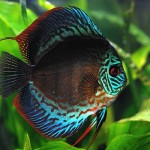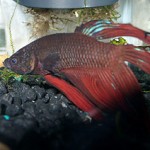When you’ve decided upon the proportions, you’re ready to begin making your aquarium. It’s a helpful thing to keep in mind that you are able to use either brass or angle iron. Brass is the simpler material to work with; iron will need the use of welding plant. Nevertheless, if iron is preferred, a garage will generally do the welding fairly cheaply.
Cut two lengths of brass angle to correspond with the total perimeter, permitting about f in. for the bends at the corners. Now mark off the angle to correspond with the lengths of the two sides and two ends. It’s greatest to work from the centre of the angle when marking out, as this technique leaves some material at every end for the final sizing after the bending has been done. Use a hack saw to cut a ‘V’ 45° every side of the vertical line that marks the lengths, leaving a little quantity of material which you are able to file away with a flat file. Carry the groove to a depth that leaves a mark on the other side of the angle. This facilitates bending.
The angle is now ready for bending, and this ought to be executed carefully to stop the brass cracking within the weakened locations.
After bending, cut the two totally free ends to the correct lengths of side and end, mitre the corners at 45°, and also the frame ought to be a nicely formed rectangle. Repeat with the other length. These two frames will probably be the base and top of the aquarium.
Thoroughly clean the joints and all of the surfaces which will be in contact, treat with flux, and tin with solder.
The corners of the top and bottom frames can now be soldered together, but make certain that the edges naturally contact every other and that no force is required to hold them together.
Extra strength could be obtained if corner brackets are soldered to every corner. It’s worthwhile to make a jig for holding the frames square whilst the soldered joint is made, and you are able to do this either with a piece of wood cut to the inside dimensions of the frames, or with blocks screwed down to the top of the work-bench after ensuring the corners are square. Don’t attempt to press the frames into shape after soldering.
The four uprights can now be cut and filed to the required length. Once more make certain that the ends are clean and well tinned with solder. These can now be soldered into the four corners of the bottom frame, making certain that they’re perfectly square and upright. A little ‘C clamp could be utilized to hold them in position until firmly fixed.
The final operation would be to solder the top frame within the exact same manner. Once more, a wooden jig could be utilized. Unless an electric soldering iron is utilized the tip will cool prior to it has time to raise the brass to the required temperature to melt the solder. Then a blow lamp or methylated spirit blow torch will probably be essential. If you’re not especially expert at soldering, you are able to drill the uprights, and use little screws and nuts to hold the entire frame together until the soldering operation is finished. The screws are then removed and also the holes plugged with brass rivets, making certain that the heads are perfectly flat on the inside of the aquarium.
If angle iron is the material chosen, the joints could be made smoother and welding is a lot stronger than solder. The angle iron ought to be cut to equal the four lengths, the four ends, and also the four uprights, and every end mitered to an angle of 45°. When this is done all ends ought to fit snugly into every other ready for welding. After the welded joint has been made, the weld could be extremely carefully hammered to supply a smooth finish.
For aquariums over 30-in. lengthy, I advise an extra stiffener across the centre of the bottom and top frame to stop bowing of the lengthy sides. Even though the bowing might be slight, it’s nearly particular to trigger a leak eventually.
The frame is now ready to be painted within the colour you’ve chosen. It’s much better to use a coat of great oil paint instead of synthetic enamels or lacquers, as these tend to chip effortlessly and also the chips eventually discover their way into the aquarium.
With an iron frame, an undercoat of red lead prevents rust eventually forcing itself via the finished coat of paint.
The inside of the frame ought to be sparingly painted with gold-size to make certain cohesion between the cement and frame.
If paraffin or gas heating would be to be utilized to maintain the temperature, a slate bottom, or preferably a sheet of fully compressed stipple glazed asbestos (not to be confused with ordinary builders’ asbestos), will probably be essential. This can generally be supplied by a great builders’ merchant, but it’s advisable to take along with you a cardboard template of the actual size required. These materials could be sawn, but are extremely abrasive, so I advise you to use an old saw if you’re cutting it your self.
Once you’ve finished the frame, you’re ready to start work on the glass. Prior to putting the glass into the frame, run a smear of gold-size round the edges. This will assist to bond it to the cement. The kind of glass to be utilized doesn’t present any issues. The front panel of glass will obviously require to be clear, but the remainder could be horticultural or rough cast.
The base ought to have a clearance of 1/16 in. between the frame and also the glass or plate. Spread the cement liberally on the bottom edge of the frame to a thickness of approximately 1/4 in., making certain that the frame is well covered; lay the glass in and press gently downwards until the cement is about 1/8 in. in thickness. Clean any surplus cement with old knife.
Next, treat the two sides within the exact same manner, and then the two ends. Some aquarists advise wedging the two sides in position with sticks across the inside of the tank, but this technique distorts the glass, to ensure that when the sticks are removed it reverts to its natural shape and causes a leak.
The cement generally begins to harden after two or 3 days, and also the aquarium can then be filled with water. The pressure of water will give a final settling to the glass. Make certain that the aquarium is on a firm base which doesn’t rock, prior to filling. Once your aquarium is filled there’s no reason to empty it unless you’ve to repair a leak, or for some other emergency.
In the event you determine on a big tank, the bottom ought to be put in after the two sides, and also the ends last. This gives extra strength.

















Leave a Reply